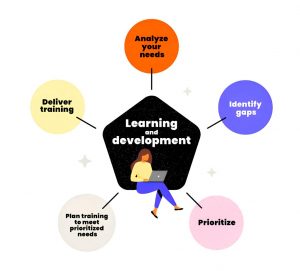In the dynamic landscape of the apparel industry, where trends evolve rapidly and consumer demands constantly shift, the significance of skilled manpower cannot be overstated. The ability to adapt to new technologies, innovate production processes, and maintain quality standards requires a workforce that is not only competent but also continually developing. This is where the Learning & Development (L&D) section plays a pivotal role in shaping the future of the industry.
 The apparel industry involves a wide range of activities, including design, manufacturing, marketing, and distribution. Each of these areas requires unique skills, from traditional craftsmanship to advanced digital capabilities. As a result, Learning and Development (L&D) in the apparel sector is versatile, addressing the varied needs of different job roles.
A key goal of L&D in the apparel industry is to connect traditional techniques with modern technologies. While traditional craftsmanship underpins many elements of apparel production, advancements like automation, robotics, and digital design software are transforming garment manufacturing. L&D programs strive to provide workers with the knowledge and skills to effectively use these technologies, thereby improving productivity and efficiency.
The apparel industry involves a wide range of activities, including design, manufacturing, marketing, and distribution. Each of these areas requires unique skills, from traditional craftsmanship to advanced digital capabilities. As a result, Learning and Development (L&D) in the apparel sector is versatile, addressing the varied needs of different job roles.
A key goal of L&D in the apparel industry is to connect traditional techniques with modern technologies. While traditional craftsmanship underpins many elements of apparel production, advancements like automation, robotics, and digital design software are transforming garment manufacturing. L&D programs strive to provide workers with the knowledge and skills to effectively use these technologies, thereby improving productivity and efficiency.
 Additionally, L&D initiatives in the apparel industry go beyond technical skills to include soft skills and managerial competencies. Skills such as effective communication, problem-solving, teamwork, and leadership are crucial for promoting a culture of innovation and continuous improvement within companies. Training programs in these areas not only boost individual performance but also enhance overall organizational success.
In addition to skill development, Training programs on occupational health and safety practices, as well as compliance with labor laws and ethical standards, help minimize risks and uphold the reputation of companies within the industry.
Additionally, L&D initiatives in the apparel industry go beyond technical skills to include soft skills and managerial competencies. Skills such as effective communication, problem-solving, teamwork, and leadership are crucial for promoting a culture of innovation and continuous improvement within companies. Training programs in these areas not only boost individual performance but also enhance overall organizational success.
In addition to skill development, Training programs on occupational health and safety practices, as well as compliance with labor laws and ethical standards, help minimize risks and uphold the reputation of companies within the industry.
 Moreover, L&D acts as a strategy for retaining talent and promoting career growth in the apparel sector. By investing in the professional development of their employees, companies can build loyalty and motivation. Offering opportunities for upskilling and career advancement not only attracts top talent but also boosts employee satisfaction and retention, thereby driving organizational success.
In conclusion, the scope of the Learning & Development section within the apparel industry is vast and varied, encompassing technical skills, soft skills, safety training, and career development initiatives. By investing in L&D, companies can nurture a skilled workforce capable of meeting the evolving demands of the industry, driving innovation, and maintaining a competitive edge in the global marketplace. As the apparel industry continues to evolve, the role of L&D in shaping the future of the workforce will become increasingly indispensable.
Moreover, L&D acts as a strategy for retaining talent and promoting career growth in the apparel sector. By investing in the professional development of their employees, companies can build loyalty and motivation. Offering opportunities for upskilling and career advancement not only attracts top talent but also boosts employee satisfaction and retention, thereby driving organizational success.
In conclusion, the scope of the Learning & Development section within the apparel industry is vast and varied, encompassing technical skills, soft skills, safety training, and career development initiatives. By investing in L&D, companies can nurture a skilled workforce capable of meeting the evolving demands of the industry, driving innovation, and maintaining a competitive edge in the global marketplace. As the apparel industry continues to evolve, the role of L&D in shaping the future of the workforce will become increasingly indispensable.
 The apparel industry involves a wide range of activities, including design, manufacturing, marketing, and distribution. Each of these areas requires unique skills, from traditional craftsmanship to advanced digital capabilities. As a result, Learning and Development (L&D) in the apparel sector is versatile, addressing the varied needs of different job roles.
A key goal of L&D in the apparel industry is to connect traditional techniques with modern technologies. While traditional craftsmanship underpins many elements of apparel production, advancements like automation, robotics, and digital design software are transforming garment manufacturing. L&D programs strive to provide workers with the knowledge and skills to effectively use these technologies, thereby improving productivity and efficiency.
The apparel industry involves a wide range of activities, including design, manufacturing, marketing, and distribution. Each of these areas requires unique skills, from traditional craftsmanship to advanced digital capabilities. As a result, Learning and Development (L&D) in the apparel sector is versatile, addressing the varied needs of different job roles.
A key goal of L&D in the apparel industry is to connect traditional techniques with modern technologies. While traditional craftsmanship underpins many elements of apparel production, advancements like automation, robotics, and digital design software are transforming garment manufacturing. L&D programs strive to provide workers with the knowledge and skills to effectively use these technologies, thereby improving productivity and efficiency.
 Additionally, L&D initiatives in the apparel industry go beyond technical skills to include soft skills and managerial competencies. Skills such as effective communication, problem-solving, teamwork, and leadership are crucial for promoting a culture of innovation and continuous improvement within companies. Training programs in these areas not only boost individual performance but also enhance overall organizational success.
In addition to skill development, Training programs on occupational health and safety practices, as well as compliance with labor laws and ethical standards, help minimize risks and uphold the reputation of companies within the industry.
Additionally, L&D initiatives in the apparel industry go beyond technical skills to include soft skills and managerial competencies. Skills such as effective communication, problem-solving, teamwork, and leadership are crucial for promoting a culture of innovation and continuous improvement within companies. Training programs in these areas not only boost individual performance but also enhance overall organizational success.
In addition to skill development, Training programs on occupational health and safety practices, as well as compliance with labor laws and ethical standards, help minimize risks and uphold the reputation of companies within the industry.
 Moreover, L&D acts as a strategy for retaining talent and promoting career growth in the apparel sector. By investing in the professional development of their employees, companies can build loyalty and motivation. Offering opportunities for upskilling and career advancement not only attracts top talent but also boosts employee satisfaction and retention, thereby driving organizational success.
In conclusion, the scope of the Learning & Development section within the apparel industry is vast and varied, encompassing technical skills, soft skills, safety training, and career development initiatives. By investing in L&D, companies can nurture a skilled workforce capable of meeting the evolving demands of the industry, driving innovation, and maintaining a competitive edge in the global marketplace. As the apparel industry continues to evolve, the role of L&D in shaping the future of the workforce will become increasingly indispensable.
Moreover, L&D acts as a strategy for retaining talent and promoting career growth in the apparel sector. By investing in the professional development of their employees, companies can build loyalty and motivation. Offering opportunities for upskilling and career advancement not only attracts top talent but also boosts employee satisfaction and retention, thereby driving organizational success.
In conclusion, the scope of the Learning & Development section within the apparel industry is vast and varied, encompassing technical skills, soft skills, safety training, and career development initiatives. By investing in L&D, companies can nurture a skilled workforce capable of meeting the evolving demands of the industry, driving innovation, and maintaining a competitive edge in the global marketplace. As the apparel industry continues to evolve, the role of L&D in shaping the future of the workforce will become increasingly indispensable. 
Anik Barman
Associate Consultant


Leave a Comment